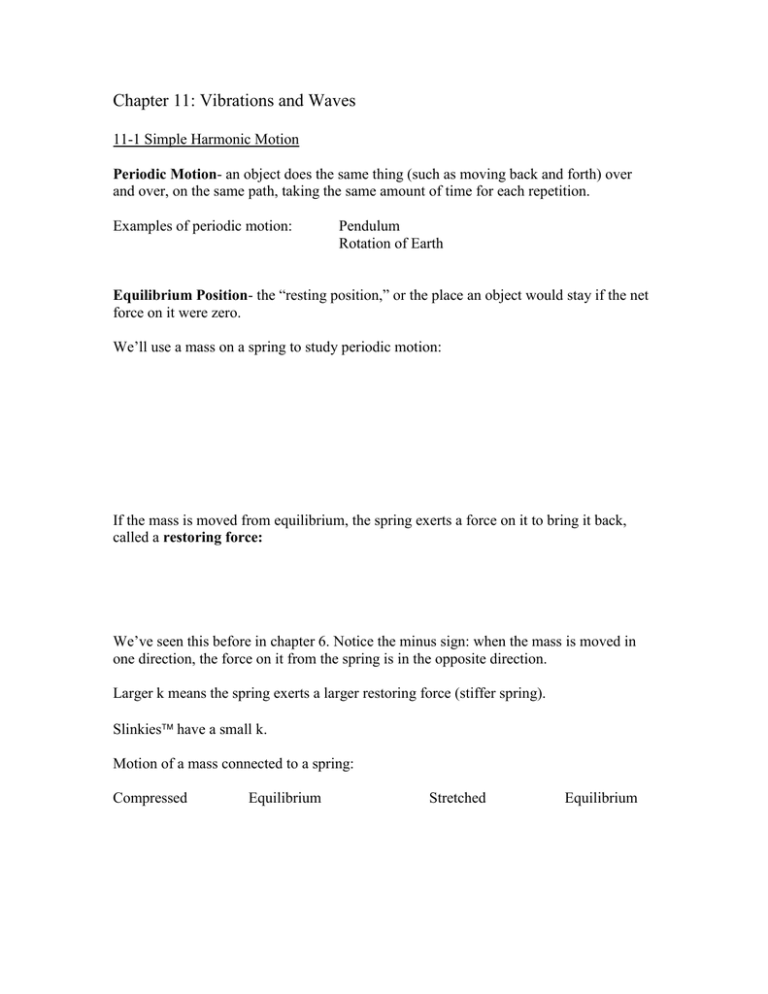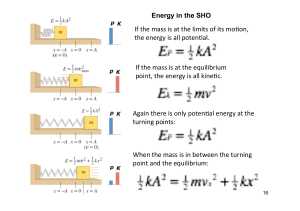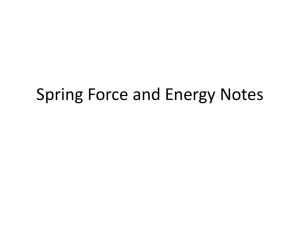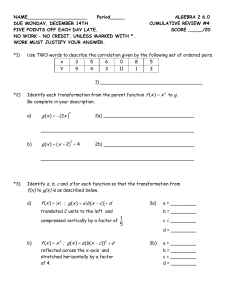Chapter 11: Vibrations and Waves
advertisement

Chapter 11: Vibrations and Waves 11-1 Simple Harmonic Motion Periodic Motion- an object does the same thing (such as moving back and forth) over and over, on the same path, taking the same amount of time for each repetition. Examples of periodic motion: Pendulum Rotation of Earth Equilibrium Position- the “resting position,” or the place an object would stay if the net force on it were zero. We’ll use a mass on a spring to study periodic motion: If the mass is moved from equilibrium, the spring exerts a force on it to bring it back, called a restoring force: We’ve seen this before in chapter 6. Notice the minus sign: when the mass is moved in one direction, the force on it from the spring is in the opposite direction. Larger k means the spring exerts a larger restoring force (stiffer spring). Slinkies have a small k. Motion of a mass connected to a spring: Compressed Equilibrium Stretched Equilibrium Displacement- distance at any time from the equilibrium position Amplitude- the largest possible displacement, the position of the mass when the spring is stretched the most or compressed the most Cycle- one complete motion, such as a mass on a spring going from the compressed position to the stretched, and then back to the compressed. The object must go through all possible positions once, and end up where it started. Period- time for one, complete cycle, also known as T Frequency- number of cycles per second, also known as f, and as 1/T 11-2 Energy in the SHO PE stored in a spring = KE of any object = Total Energy of a spring and mass system = Energy is conserved if only conservative forces act, so no friction is present. Energy stored in a compressed spring: Maximum kinetic energy: Energy at points in between: Solve for v: Solve for maximum v: Now we have v at points in between in terms of vmax: 11-3 The Period and Sinusoidal Nature of SHM The period of a mass on a spring depends on the spring stiffness k and the mass m, but not on how far you stretch the spring (the amplitude A). Look at just the x-component of circular motion, with v around the circle = maximum v: Figure 11-6 Circular and Simple Harmonic Motion The person sees the object moving back and forth, with v going from zero at the edges, to v max in the middle of the motion (just like a mass on a spring!) Compare the two similar triangles, one made from the velocity and its x and y components, and the other made from the radius of the circle and the x and y position components: Notice that the x-component of the speed looks just like the speed of the mass on the spring (our SHO): We can find the period of the motion in the x direction in the same way we defined the period for circular motion: Using conservation of energy for our mass on a spring: the period becomes: How position changes in time: The x-component of circular motion changes in time the same way the position of our mass on a spring changes with time: We know that theta changes in time according to: So the position changes in time: Here is what the cosine function looks like: This fits our initial conditions, that the spring is compressed (so position is at a maximum), and our initial speed is zero (remember, speed is the slope of the position graph): What if we changed our initial conditions, so that we started at x = 0, and gave the mass a shove (a maximum speed at the beginning)? Our graph would look like the sine function instead: Figure 11-9 Sinusoidal nature of SHM as a function of time



